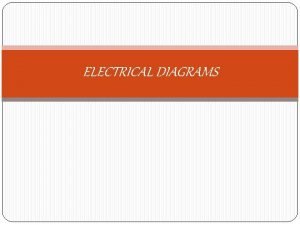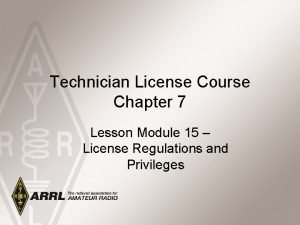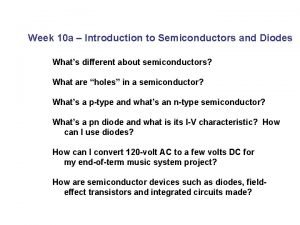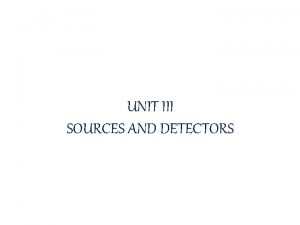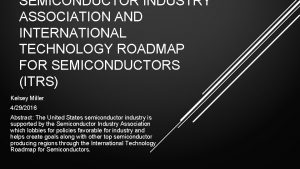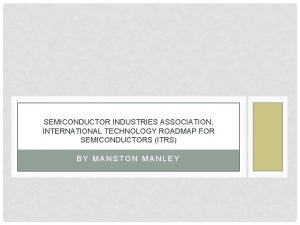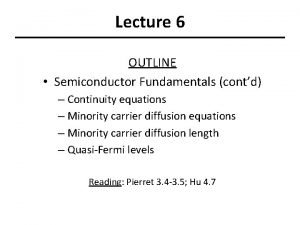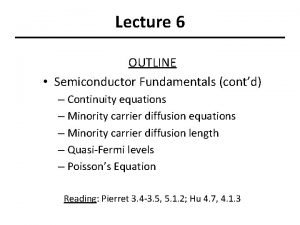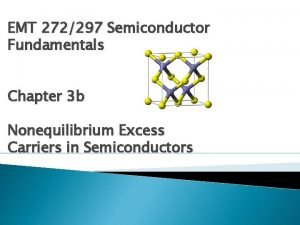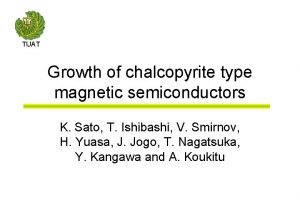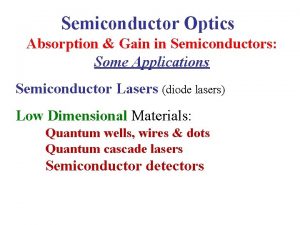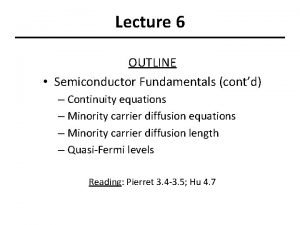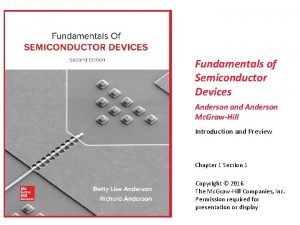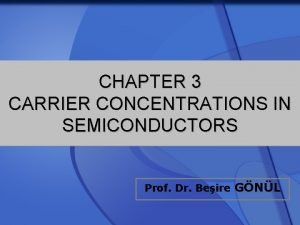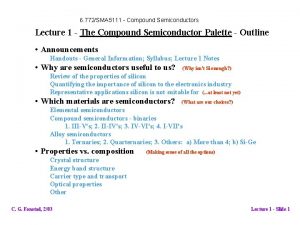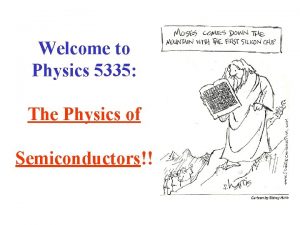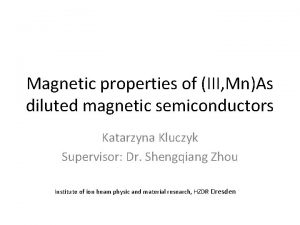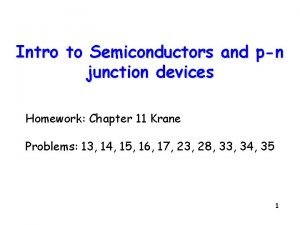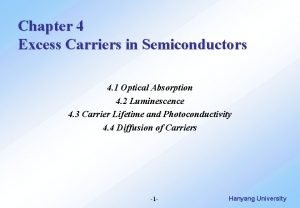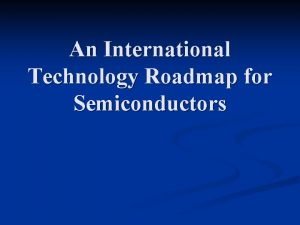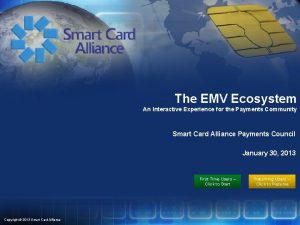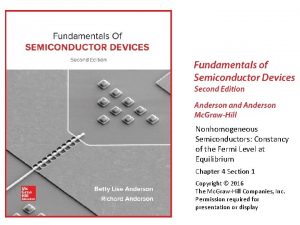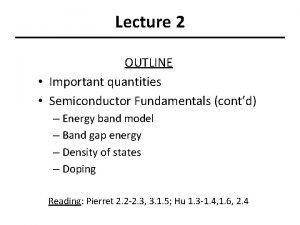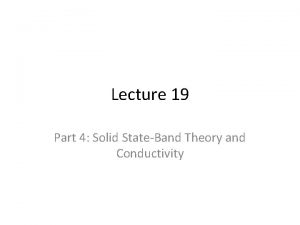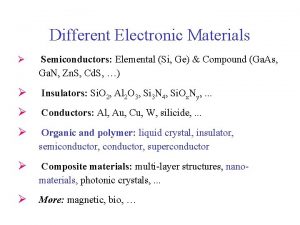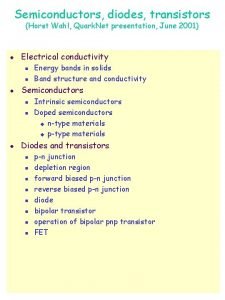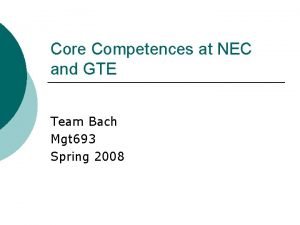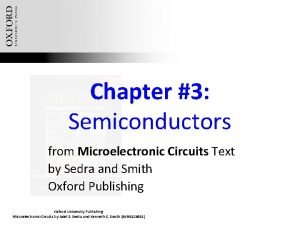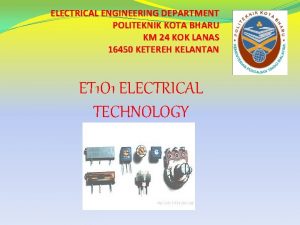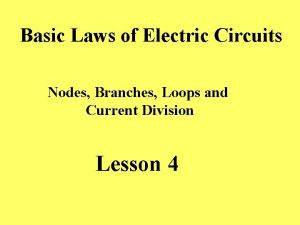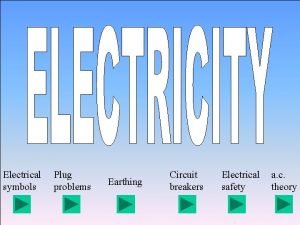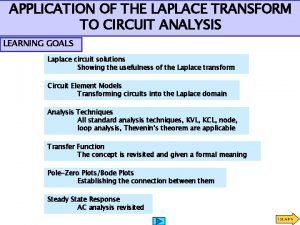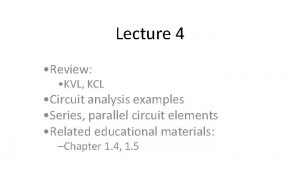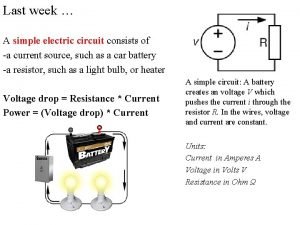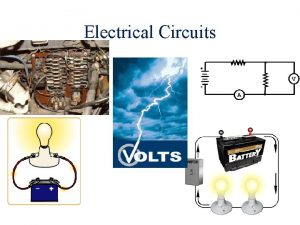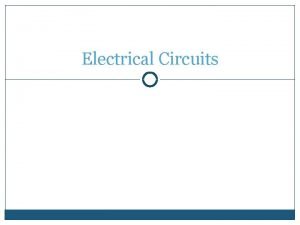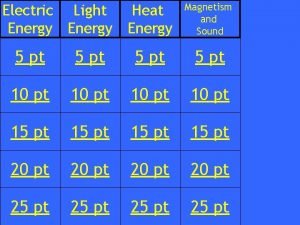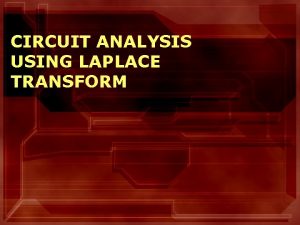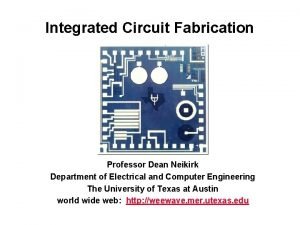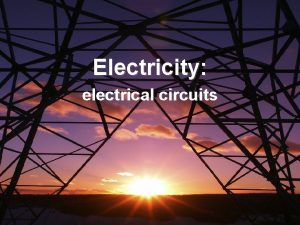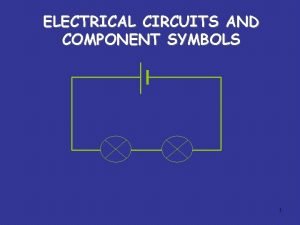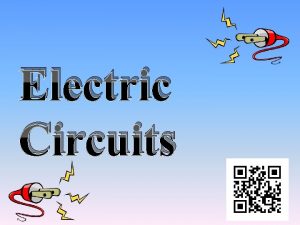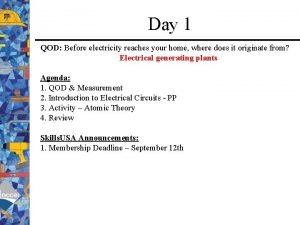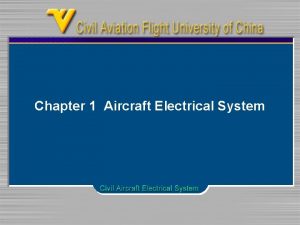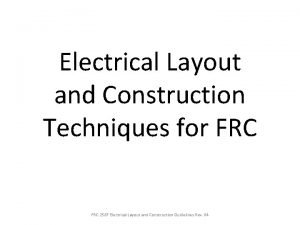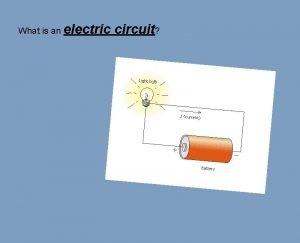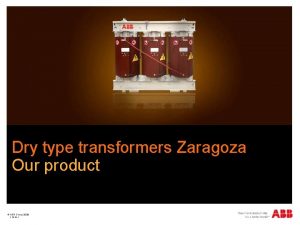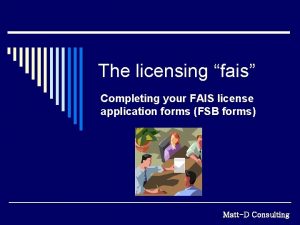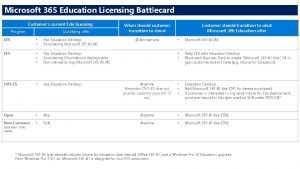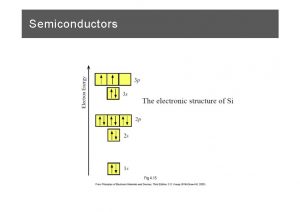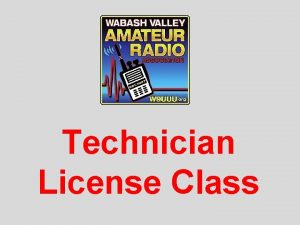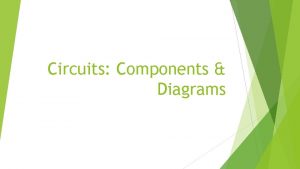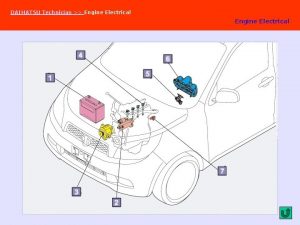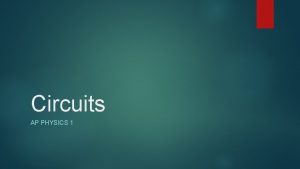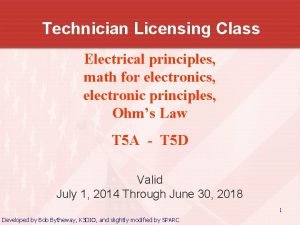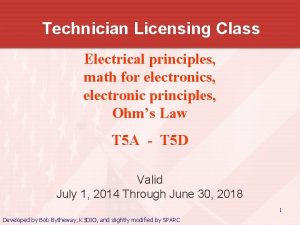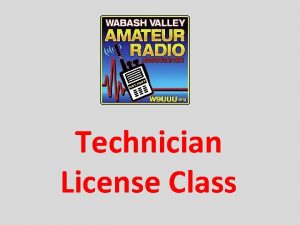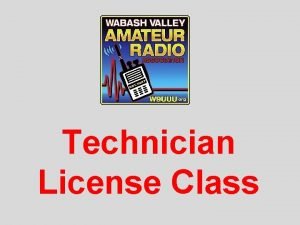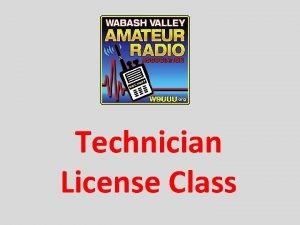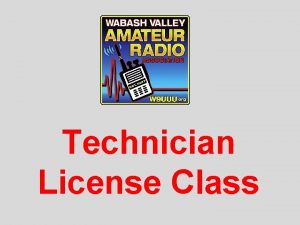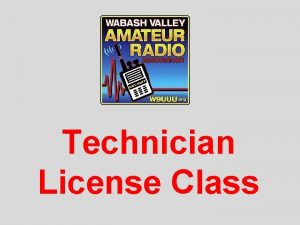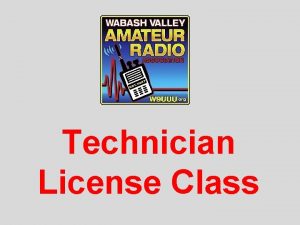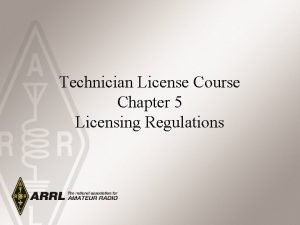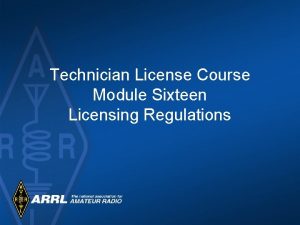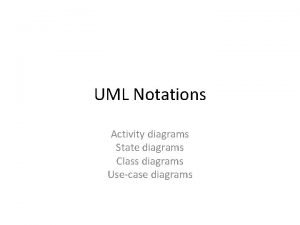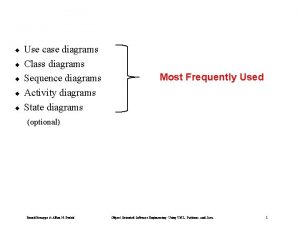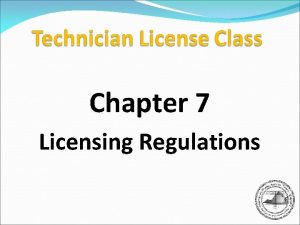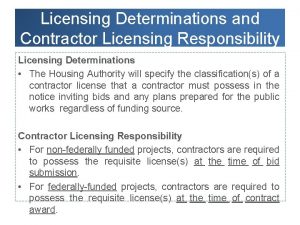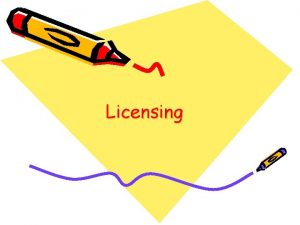Technician Licensing Class Electrical components semiconductors circuit diagrams






































































- Slides: 70

Technician Licensing Class Electrical components, semiconductors, circuit diagrams, component functions T 6 A - T 6 D Valid July 1, 2014 Through June 30, 2018 1 Developed by Bob Bytheway, K 3 DIO, and slightly modified by SPARC

T 6 A • The electrical component used to oppose the flow of current in a DC circuit is the resistor. T 6 A 01 • The component often used as an adjustable volume control is the potentiometer. T 6 A 02 • The electrical parameter controlled by a potentiometer is resistance. T 6 A 03 2

T 6 A • The electrical component that stores energy in an electric field is the capacitor. T 6 A 04 • The type of electrical component that consists of two or more conductive surfaces separated by an insulator is a capacitor. T 6 A 05 3

T 6 A • The electrical component that stores energy in a magnetic field is an inductor. T 6 A 06 • The electrical component usually composed of a coil of wire is an inductor. T 6 A 07 • The electrical component used to connect or disconnect electrical circuits is the switch. T 6 A 08 • The electrical component used to protect other circuit components from current overload is the fuse. T 6 A 09 4

T 6 A • These battery types are rechargeable: Ø Nickel-metal hydride; Ø Lithium-ion; Ø Lead-acid gel-cell ü All of these choices are correct. T 6 A 10 • This type of battery is not rechargeable: Carbon-zinc. T 6 A 11 5

T 6 B • The class of electronic components that are capable of using a voltage or current signals to control current flow are transistors. T 6 B 01 • The electronic component that allows current to flow in only one direction is the diode. T 6 B 02 • The component that can be used as an electronic switch or amplifier is the transistor. T 6 B 03 6

T 6 B • The component made from three layers of semiconductor material is the transistor. T 6 B 04 • The transistor is an electronic component that can amplify signals. T 6 B 05 • The cathode lead of a semiconductor diode is usually identified with a stripe. T 6 B 06 7

T 6 B • The abbreviation LED stands for Light Emitting Diode. T 6 B 07 8

T 6 B • The abbreviation FET stands for field effect transistor. T 6 B 08 9

T 6 B • The two electrodes of a diode are the Anode and Cathode. T 6 B 09 • The three electrodes of a PNP or NPN transistor are emitter, base, and collector. T 6 B 10 • The three electrodes of a field effect transistor are source, gate, and drain. T 6 B 11 • The term that describes a transistor’s ability to amplify a signal is gain. T 6 B 12 10

T 6 C • The name for standardize representations of components in an electrical wiring diagram is Schematic Symbols. • Component #1 in Figure T 1 is a Resistor. T 6 C 01 T 6 C 02 Figure T 1 • Component #2 in Figure T 1 is a Transistor. T 6 C 03 11

T 6 C • Component #3 in Figure T 1 is a Lamp. T 6 C 04 Figure T 1 • Component #4 in Figure T 1 is a Battery. T 6 C 05 12

T 6 C • Component #6 in Figure T 2 is a capacitor. T 6 C 06 Figure T 2 • Component #8 in Figure T 2 is a light emitting diode. • Component #9 in Figure T 2 is a variable resistor. T 6 C 07 T 6 C 08 13

T 6 C • Component #4 in Figure T 2 is a transformer. T 6 C 09 Figure T 2 14

T 6 C • The component #3 in figure T 3 is a variable inductor. T 6 C 10 Figure T 3 • The component #4 in figure T 3 is an antenna. T 6 C 11 15

T 6 C • The symbols on an electrical circuit schematic diagram represent electrical components. T 6 C 12 • The way components are interconnected is accurately represented in electrical circuit schematic diagrams. T 6 C 13 16

T 6 D • The device or circuit that changes an alternating current in to a varying direct current signal is the rectifier. T 6 D 01 • A switch controlled by an electromagnet describes a relay. T 6 D 02 • Component #3 in Figure T 2 is a single-pole, single-throw switch. T 6 D 03 Figure T 2 17

T 6 D • A meter can be used to display signal strength on a numeric scale. T 6 D 04 • A regulator is a type of circuit that controls the amount of voltage from a power supply. T 6 D 05 • The component commonly used to change 120 V AC house current to a lower AC voltage for other uses is a transformer. T 6 D 06 18

T 6 D • A device commonly used as a visual indicator is an LED. T 6 D 07 • A capacitor is used together with an inductor to make a tuned circuit. • The name of a device that combines several semiconductors and other components into one package is integrated circuits. T 6 D 08 T 6 D 09 19

T 6 D • The name of a device that combines several semiconductors and other components into one package is integrated circuits. T 6 D 09 • The function of component #2 in Figure T 1 is to control the flow of current. Figure T 1 T 6 D 10 20

T 6 D • A simple resonant or tuned circuit consists of an inductor and a capacitor connected in series or parallel to form a filter. T 6 D 11 • A common reason to use shielded wire is to prevent coupling of unwanted signals to or from the wire. T 6 D 12 21

Element 2 Technician Class Question Pool T 6 A–T 6 D Valid July 1, 2014 Through June 30, 2018 22

T 6 A 01 What electrical component is used to oppose the flow of current in a DC circuit? A. B. C. D. Inductor Resistor Voltmeter Transformer 23

T 6 A 02 What type of component is often used as an adjustable volume control? A. B. C. D. Fixed resistor Power resistor Potentiometer transformer 24

T 6 A 03 What electrical parameter is controlled by a potentiometer? A. B. C. D. Inductance Resistance Capacitance Field strength 25

T 6 A 04 What electrical component stores energy in an electric field? A. B. C. D. Resistor Capacitor Inductor Diode 26

T 6 A 05 What type of electrical component consists of two or more conductive surfaces separated by an insulator? A. B. C. D. Resistor Potentiometer Oscillator Capacitor 27

T 6 A 06 What type of electrical component stores energy in a magnetic field? A. B. C. D. Resistor Capacitor Inductor Diode 28

T 6 A 07 What electrical component is usually composed of a coil of wire? A. B. C. D. Switch Capacitor Diode Inductor 29

T 6 A 08 What electrical component is used to connect or disconnect electrical circuits? A. B. C. D. Magnetron Switch Thermistor All of these choices are correct 30

T 6 A 09 What electrical component is used to protect other circuit components from current overloads? A. B. C. D. Fuse Capacitor Inductor All of these choices are correct 31

T 6 A 10 Which of the following battery types is rechargeable? A. B. C. D. Nickel-metal hydride Lithium-ion Lead-acid gel-cell All of these choices are correct 32

T 6 A 11 Which of the following battery types is not rechargeable? A. B. C. D. Nickel-cadmium Carbon-zinc Lead-acid Lithium-ion 33

T 6 B 01 What class of electronic components is capable of using a voltage or current signal to control current flow? A. Capacitors B. Inductors C. Resistors D. Transistors 34

T 6 B 02 What electronic component allows current to flow in only one direction? A. B. C. D. Resistor Fuse Diode Driven element 35

T 6 B 03 Which of these components can be used as an electronic switch or amplifier? A. B. C. D. Oscillator Potentiometer Transistor Voltmeter 36

T 6 B 04 Which of the following components can be made of three layers of semiconductor material? A. B. C. D. Alternator Transistor Triode Pentagrid converter 37

T 6 B 05 Which of the following electronic components can amplify signals? A. B. C. D. Transistor Variable resistor Electrolytic capacitor Multi-cell battery 38

T 6 B 06 How is cathode lead of a semiconductor diode usually identified? A. B. C. D. With the word cathode With a stripe With the letter C All of these choices are correct 39

T 6 B 07 What does the abbreviation "LED" stand for? A. B. C. D. Low Emission Diode Light Emitting Diode Liquid Emission Detector Long Echo Delay 40

T 6 B 08 What does the abbreviation FET stand for? A. B. C. D. Field Effect Transistor Fast Electron Transistor Free Electron Transition Field Emission Thickness 41

T 6 B 09 What are the names of the two electrodes of a diode? A. B. C. D. Plus and minus Source and drain Anode and cathode Gate and base 42

T 6 B 10 What are three electrodes of a PNP or NPN transistor? A. B. C. D. Emitter, base, and collector Source, gate, and drain Cathode, grid, and plate Cathode, drift cavity, and collector 43

T 6 B 11 What at are three electrodes of a field effect transistor? A. B. C. D. Emitter, base, and collector Source, gate, and drain Cathode, grid, and plate Cathode, gate, and anode 44

T 6 B 12 What is the term that describes a transistor's ability to amplify a signal? A. B. C. D. Gain Forward resistance Forward voltage drop On resistance 45

T 6 C 01 What is the name for standardized representations of components in an electrical wiring diagram? A. B. C. D. Electrical depictions Grey sketch Schematic symbols Component callouts 46

T 6 C 02 What is component 1 in figure T 1? A. B. C. D. Resistor Transistor Battery connector 47

T 6 C 03 What is component 2 in figure T 1? A. B. C. D. Resistor Transistor Indicator lamp Connector 48

T 6 C 04 What is component 3 in figure T 1? A. B. C. D. Resistor Transistor Lamp Ground symbol 49

T 6 C 05 What is component 4 in figure T 1? A. B. C. D. Resistor Transistor Battery Ground symbol 50

T 6 C 06 What is component 6 in figure T 2? A. B. C. D. Resistor Capacitor Regulator IC Transistor 51

T 6 C 07 What is component 8 in figure T 2? A. B. C. D. Resistor Inductor Regulator IC Light emitting diode 52

T 6 C 08 What is component 9 in figure T 2? A. B. C. D. Variable capacitor Variable inductor Variable resistor Variable transformer 53

T 6 C 09 What is component 4 in figure T 2? A. B. C. D. Variable inductor Double-pole switch Potentiometer Transformer 54

T 6 C 10 What is component 3 in figure T 3? A. B. C. D. Connector Meter Variable capacitor Variable inductor 55

T 6 C 11 What is component 4 in figure T 3? A. B. C. D. Antenna Transmitter Dummy load Ground 56

T 6 C 12 What do the symbols on an electrical circuit schematic diagram represent? A. B. C. D. Electrical components Logic states Digital codes Traffic nodes 57

T 6 C 13 Which of the following is accurately represented in electrical circuit schematic diagrams? A. B. C. D. Wire lengths Physical appearance of components The way components are interconnected All of these choices 58

T 6 D 01 Which of the following devices or circuits changes an alternating current into a varying direct current signal? A. B. C. D. Transformer Rectifier Amplifier Reflector 59

T 6 D 02 What best describes a relay? A. A switch controlled by an electromagnet B. A current controlled amplifier C. An optical sensor D. A pass transistor 60

T 6 D 03 What type of switch is represented by item 3 in figure T 2? A. B. C. D. Single-pole single-throw Single-pole double-throw Double-pole single-throw Double-pole double-throw 61

T 6 D 04 Which of the following can be used to display signal strength on a numeric scale? A. B. C. D. Potentiometer Transistor Meter Relay 62

T 6 D 05 What type of circuit controls the amount of voltage from a power supply? A. B. C. D. Regulator Oscillator Filter Phase inverter 63

T 6 D 06 What component is commonly used to change 120 V AC house current to a lower AC voltage for other uses? A. B. C. D. Variable capacitor Transformer Transistor Diode 64

T 6 D 07 Which of the following is commonly used as a visual indicator? A. B. C. D. LED FET Zener diode Bipolar transistor 65

T 6 D 08 Which of the following is used together with an inductor to make a tuned circuit? A. B. C. D. Resistor Zener diode Potentiometer Capacitor 66

T 6 D 09 What is the name of a device that combines several semiconductors and other components into one package? A. B. C. D. Transducer Multi-pole relay Integrated circuit Transformer 67

T 6 D 10 What is the function of component 2 in Figure T 1? A. Give off light when current flows through it B. Supply electrical energy C. Control the flow of current D. Convert electrical energy into radio waves 68

T 6 D 11 What is a simple resonant or tuned circuit? A. An inductor and a capacitor connected in series or parallel to form a filter B. A type of voltage regulator C. A resistor circuit used for reducing standing wave ratio D. A circuit designed to provide high fidelity audio 69

T 6 D 12 Which of the following is a common reason to use shielded wire? A. To decrease the resistance of DC power connections B. To increase the current carrying capability of the wire C. To prevent coupling of unwanted signals to or from the wire D. To couple the wire to other signals 70
 The interaction diagrams, use case diagrams are called as
The interaction diagrams, use case diagrams are called as Rake symbol in activity diagram
Rake symbol in activity diagram ø electrical symbol
ø electrical symbol Technician class privileges
Technician class privileges Introduction to semiconductors
Introduction to semiconductors Direct and indirect band gap semiconductors
Direct and indirect band gap semiconductors Semiconductor technology roadmap
Semiconductor technology roadmap Semiconductor technology roadmap
Semiconductor technology roadmap Continuity equation semiconductor
Continuity equation semiconductor Equation of continuity in semiconductors
Equation of continuity in semiconductors Equation of continuity in semiconductors
Equation of continuity in semiconductors Atomic layer deposition for semiconductors
Atomic layer deposition for semiconductors Konduktor isolator semikonduktor
Konduktor isolator semikonduktor Equipement used for making semiconductors
Equipement used for making semiconductors Optical loss and gain in semiconductors
Optical loss and gain in semiconductors Derivation of continuity equation in semiconductor
Derivation of continuity equation in semiconductor Fundamentals of semiconductor devices anderson
Fundamentals of semiconductor devices anderson Band gaps of semiconductors
Band gaps of semiconductors Elemental and compound semiconductors
Elemental and compound semiconductors The physics of semiconductors
The physics of semiconductors σsk
σsk Semiconductor junction devices
Semiconductor junction devices Quasi fermi level
Quasi fermi level The international technology roadmap for semiconductors
The international technology roadmap for semiconductors Bank of america semiconductors
Bank of america semiconductors 2 types of semiconductor
2 types of semiconductor Semiconductor examples
Semiconductor examples Semiconductors band gap
Semiconductors band gap Semiconductors band gap
Semiconductors band gap Elemental and compound semiconductors
Elemental and compound semiconductors Semiconductors
Semiconductors Nhanced semiconductors
Nhanced semiconductors Nec semiconductors livingston
Nec semiconductors livingston Semiconductors
Semiconductors Electrical circuit politeknik
Electrical circuit politeknik Branches of electricity
Branches of electricity Incomplete electrical circuit
Incomplete electrical circuit Circuit breaker electrical symbol
Circuit breaker electrical symbol Laplace circuit analysis examples
Laplace circuit analysis examples Kcl study notes
Kcl study notes Electric circuit consists of
Electric circuit consists of Electrical circuit
Electrical circuit Flashlight electrical circuit
Flashlight electrical circuit Electrical circuit
Electrical circuit S domain circuit analysis
S domain circuit analysis Three elements of electricity
Three elements of electricity Dean neikirk
Dean neikirk Electric current drawing
Electric current drawing Label the parts of the circuit diagram
Label the parts of the circuit diagram Electric current in series circuit
Electric current in series circuit An electrical circuit contains at minimum a
An electrical circuit contains at minimum a Aircraft electrical system components
Aircraft electrical system components Frc control system layout
Frc control system layout Disadvantages of series circuits
Disadvantages of series circuits Types of circuit
Types of circuit Circuit construction kit
Circuit construction kit Parallel circuit vs series circuit
Parallel circuit vs series circuit Short in parallel circuit
Short in parallel circuit Formula for venn diagram with 3 circles
Formula for venn diagram with 3 circles Pulmonary circuit and systemic circuit
Pulmonary circuit and systemic circuit Advantages of parallel circuits over series circuit
Advantages of parallel circuits over series circuit Circuit components symbols
Circuit components symbols Electrical endurance class e2
Electrical endurance class e2 Wi ems wards
Wi ems wards Veritas vems
Veritas vems Dbhds office of human rights
Dbhds office of human rights Fais penn state
Fais penn state Qualtrics psu
Qualtrics psu Qlik license types
Qlik license types Module 4 - open source software and licensing
Module 4 - open source software and licensing Microsoft education licensing
Microsoft education licensing


